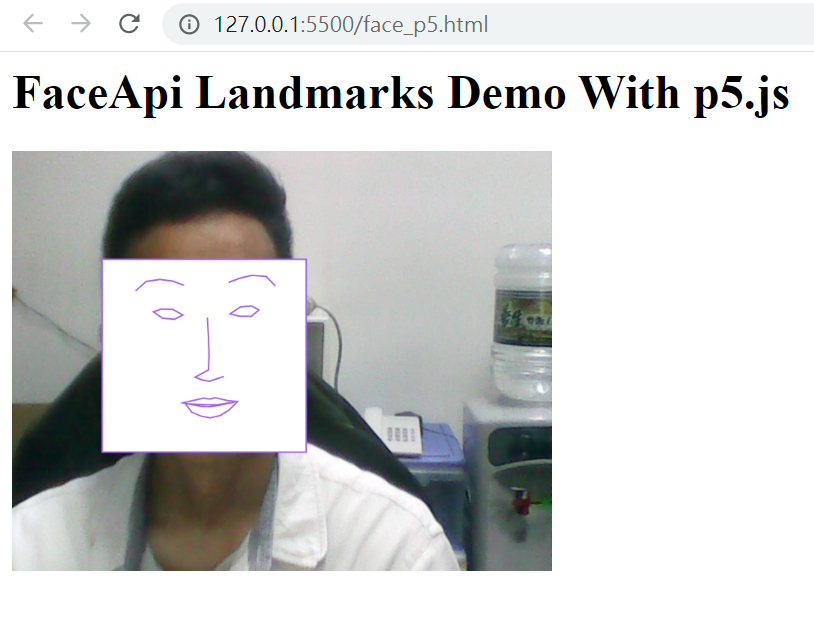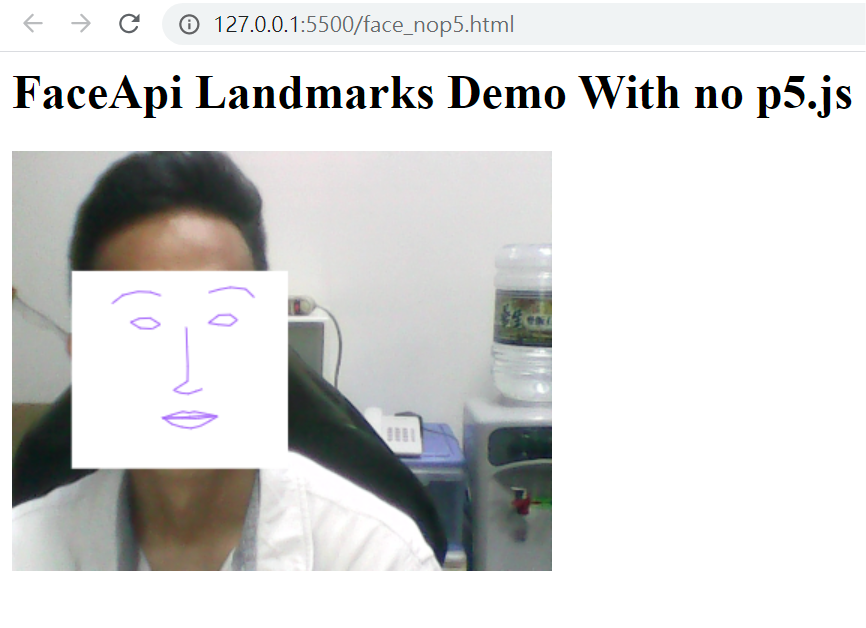首先介紹什麼是 p5.js,
p5.js 是基於 Processing 在瀏覽器中提供友善的畫布 (canvas) 使用介面。(https://creativecoding.in/2020/04/24/p5-js-%E5%BF%AB%E9%80%9F%E4%B8%8A%E6%89%8B/)
p5.js 與 ml5 的共同點是它們都可以透過瀏覽器使用 GPU 及 GPU 的專屬記憶體。
接著備料,
face_p5.html 的程式碼如下—
<html>
<head>
<meta charset="UTF-8">
<title>FaceApi Landmarks Demo With p5.js</title>
<script src="https://cdnjs.cloudflare.com/ajax/libs/p5.js/0.9.0/p5.min.js"></script>
<script src="https://cdnjs.cloudflare.com/ajax/libs/p5.js/0.9.0/addons/p5.dom.min.js"></script>
<script src="https://unpkg.com/ml5@latest/dist/ml5.min.js"></script>
</head>
<body>
<h1>FaceApi Landmarks Demo With p5.js</h1>
<script src="sketch_face_p5.js"></script>
</body>
</html>
face_nop5.html 的程式碼如下—
<html>
<head>
<meta charset="UTF-8">
<title>FaceApi Landmarks Demo With no p5.js</title>
<script src="https://unpkg.com/ml5@latest/dist/ml5.min.js" type="text/javascript"></script>
</head>
<body>
<h1>FaceApi Landmarks Demo With no p5.js</h1>
<script src="sketch_face_nop5.js"></script>
</body>
</html>
sketch_face_p5.js 的程式碼如下—
let faceapi;
let video;
let detections;
const detection_options = {
withLandmarks: true,
withDescriptors: false
}
let width = 360;
let height = 280;
function setup() {
createCanvas(width, height);
// load up your video
video = createCapture(VIDEO);
video.size(width, height);
video.hide(); // Hide the video element, and just show the canvas
faceapi = ml5.faceApi(video, detection_options, modelReady);
}
function modelReady() {
console.log('ready!');
faceapi.detect(gotResults);
}
function gotResults(err, result) {
if (err) {
console.log(err);
return;
}
// console.log(result)
detections = result;
image(video, 0, 0, width, height);
if (detections) {
if (detections.length > 0) {
drawLandmarks(detections);
}
}
faceapi.detect(gotResults);
}
function drawLandmarks(detections) {
stroke(161, 95, 251);
for (let i = 0; i < detections.length; i++) {
const alignedRect = detections[i].alignedRect;
const x = alignedRect._box._x;
const y = alignedRect._box._y;
const boxWidth = alignedRect._box._width;
const boxHeight = alignedRect._box._height;
rect(x, y, boxWidth, boxHeight);
const mouth = detections[i].parts.mouth;
const nose = detections[i].parts.nose;
const leftEye = detections[i].parts.leftEye;
const rightEye = detections[i].parts.rightEye;
const rightEyeBrow = detections[i].parts.rightEyeBrow;
const leftEyeBrow = detections[i].parts.leftEyeBrow;
drawPart(mouth, true);
drawPart(nose, false);
drawPart(leftEye, true);
drawPart(leftEyeBrow, false);
drawPart(rightEye, true);
drawPart(rightEyeBrow, false);
}
}
function drawPart(feature, closed) {
beginShape();
for (let i = 0; i < feature.length; i++) {
const x = feature[i]._x;
const y = feature[i]._y;
vertex(x, y);
}
if (closed === true) {
endShape(CLOSE);
} else {
endShape();
}
}
sketch_face_nop5.js 的程式碼如下—
let faceapi;
let video;
let detections;
const detection_options = {
withLandmarks: true,
withDescriptors: false
}
let width = 360;
let height = 280;
window.addEventListener('DOMContentLoaded', function () {
setup();
});
async function setup() {
createCanvas(width, height);
// load up your video
video = await getVideo();
faceapi = ml5.faceApi(video, detection_options, modelReady);
}
let canvas, ctx;
function createCanvas(w, h) {
canvas = document.createElement("canvas");
canvas.width = w;
canvas.height = h;
document.body.appendChild(canvas);
ctx = canvas.getContext('2d');
}
async function getVideo() {
const videoElement = document.createElement('video');
videoElement.width = width;
videoElement.height = height;
videoElement.setAttribute("style", "display: none;"); // Hide the video element, and just show the canvas
document.body.appendChild(videoElement);
// Create a webcam capture
const capture = await navigator.mediaDevices.getUserMedia({ video: true });
videoElement.srcObject = capture;
videoElement.play();
return videoElement;
}
function modelReady() {
console.log('ready!');
faceapi.detect(gotResults);
}
function gotResults(err, result) {
if (err) {
console.log(err);
return;
}
// console.log(result)
detections = result;
ctx.drawImage(video, 0, 0, width, height);
if (detections) {
if (detections.length > 0) {
drawLandmarks(detections);
}
}
faceapi.detect(gotResults);
}
function drawLandmarks(detections) {
ctx.strokeStyle = "#a15ffb";
for (let i = 0; i < detections.length; i++) {
const alignedRect = detections[i].alignedRect;
const x = alignedRect._box._x;
const y = alignedRect._box._y;
const boxWidth = alignedRect._box._width;
const boxHeight = alignedRect._box._height;
ctx.beginPath();
ctx.rect(x, y, boxWidth, boxHeight);
ctx.fillStyle = "white";
ctx.fill();
const mouth = detections[i].parts.mouth;
const nose = detections[i].parts.nose;
const leftEye = detections[i].parts.leftEye;
const rightEye = detections[i].parts.rightEye;
const rightEyeBrow = detections[i].parts.rightEyeBrow;
const leftEyeBrow = detections[i].parts.leftEyeBrow;
drawPart(mouth, true);
drawPart(nose, false);
drawPart(leftEye, true);
drawPart(leftEyeBrow, false);
drawPart(rightEye, true);
drawPart(rightEyeBrow, false);
}
}
function drawPart(feature, closed) {
ctx.beginPath();
for (let i = 0; i < feature.length; i++) {
const x = feature[i]._x;
const y = feature[i]._y;
if (i === 0) {
ctx.moveTo(x, y);
} else {
ctx.lineTo(x, y);
}
}
if (closed === true) {
ctx.closePath();
}
ctx.stroke();
}
備料完成後,就可啟動 Live Server,
在 VS Code 裡的 face_p5.html 程式碼按右鍵,在顯示的內容選單裡,點選 Open with Live Server,
就可顯示如下畫面。(會先跳出詢問是否讓此網頁有使用網路攝影機的權限,請按同意)
face_nop5.html 同上的步驟啟動,
就可顯示如下畫面。
可見兩者的執行結果是一樣的。
使用 WinMerge 比較 sketch_face_p5.js 與 sketch_face_nop5.js 的差異,
就可以了解 p5.js 能做的, javascript 原本就能做到,
但 p5.js 真的把程式碼變得更簡潔,在這個例子幾乎減少了四分之一的程式碼。
所以, p5.js 及 ml5 都是讓程式設計師在使用新技術時,可以更專注在
客製化的需求。
